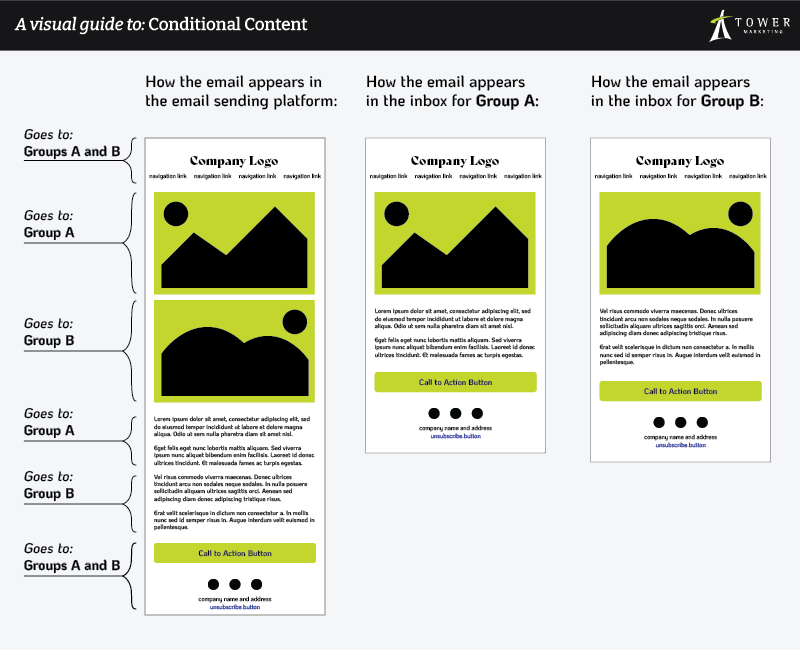4 Personalized Email Marketing Tactics to Boost Engagement
- Email Marketing & Automation
- Marketing Strategy

Creating a genuine connection with your customers via email can sometimes be difficult. Messages sent on such a large scale often feel cold, impersonal, and ill-timed.
Fortunately, email marketers now have the resources at their disposal to create purposeful communications that meet contacts at each stage of their journey and provide content tailored specifically to their needs.
These personalized email marketing tactics will help you elevate your email marketing and develop a more meaningful relationship with your audience.
What Is Email Personalization?
Personalized email consists of more than just inserting someone’s first name at the beginning of your email message. Your goal should be to create a personalized experience – a customer journey that feels organic and responsive.
The first step in this process is to understand how prospects and customers interact with your business specifically and develop a strategy accordingly. Every brand is different, so knowing the needs and expectations of your contacts is essential for successful personalized email interactions.
The Benefits of Personalized Email Marketing
Looking for evidence of how effective these personalized email marketing tactics can be? Here are some eye-opening statistics to consider:
- 71% of consumers expect companies to offer personalized communication, and 76% get frustrated when it doesn’t happen. (McKinsey & Company)
- 90% of consumers are more likely to make a purchase when brands offer personalized experiences. (123FormBuilder)
- 90% of U.S. consumers find personalized marketing content somewhat to very appealing. (Statista)
- Segmentation of email campaigns can increase revenue by up to 760%. (Hubspot)
- Emails with personalized subject lines are 26% more likely to be opened. (Campaign Monitor)
4 Highly Effective Personalized Email Marketing Tactics You Should Be Using
Leveraging the strategies outlined below will help you deliver more meaningful content and product offerings to the people who’ve entrusted you with their contact information and personal data.
1. Segmenting
Before you hit send on your next email campaign, ask yourself: Is this relevant to everyone on my list?
Segmenting is a powerful tool used to create niche subgroups you can then target with more relevant messaging. It is essentially the opposite of the outdated “spray and pray” email marketing strategy (sending each message to everyone on your list regardless of a contact’s likelihood to interact with it).
The segments you create might include those who have (or have not) opened an email, clicked a link, or made a purchase. The beauty of segmenting is that unlike static lists of contacts, segments will update automatically in real-time based on your subscriber’s behavior.
Segmenting is also important for creating a clean and well-maintained email list, which is an integral part of effective ongoing email marketing.
2. Timing
Sending the right message to the right person at the right time is the key to successful email marketing, but the timing aspect of that winning formula often isn’t given as much thought as it deserves.
Here are some examples of common drip campaigns and when they should be scheduled (of course, every business is different, so you may need to make adjustments according to your own customer base):
- A welcome email should go out immediately when someone provides you their email for the first time.
- An abandoned cart message should be sent while your offering is still top of mind. Reaching out less than an hour after they leave your site is probably too soon, but more than three hours after may also be too late.
- An email asking someone to review a product should be sent a few days post delivery/installation so the consumer has time to evaluate their purchase.
- A re-engagement email should be sent 3-6 months after the last time someone opened an email from you.
Automated emails like these that trigger based on a contact’s actions almost always result in dramatically higher open dates than a typical monthly newsletter.
Anniversaries and birthdays are also ideal times to reach out to customers via email and offer them coupons, discounts, or promotions.

3. Personalized Content
Personalized content is created using the data we store on our contacts, from first and last names to their pronouns, job title, or geographic location.
Having accurate information about your contact is key to creating personalized messaging. It’s also important to gather this data in a straightforward and transparent way. (See this article explaining why you should never rent or purchase an email list.)
You can ethically acquire information about your potential and current customers in the form of newsletter sign-up forms, interest surveys, contests, quizzes, or gated coupons.
Including this information in your subject line, preview text, or email body is fairly simple and straightforward. It typically consists of using a placeholder like %FIRSTNAME% or %LASTNAME% that will pull in the data dynamically for each individual.
The more challenging task? Using those personal details in a way that feels natural.
Below are a few examples of personalized subject lines I’ve received. Some were excellent and engaging, while others felt clunky and forced.
Good example:
Welcome, Danae! Here’s what you need to know.
This example is both friendly and straightforward. The addition of the first name and emoji usage is the perfect way to offset the overall frankness of the message.
Bad example:
Danae, create crazily effective content!
Simply tacking on someone’s first name at the start of a subject line you’ve already written will always feel forced. Personalization needs to be used deftly to have the desired effect.
Good example:
Wondering where to begin, Danae? We have a few ideas
This subject line addresses the fact that I may be looking for guidance, and the inclusion of the first name here implies the information provided will be relevant to me specifically.
Bad example:
Marketing insights for Danae
This makes me feel as though I’m being spoken about, not spoken to. It also lacks the conversational tone I’m looking for when a subject line includes my first name.
Here’s a quick rule of thumb to follow: if the person’s name can easily be replaced with “you” without drastically changing the tone of the sentence, it’s worth considering a rewrite.
Another personalization tip to keep in mind: People like being spoken to like a person and by a person. Instead of sending emails from your company name with a no-reply address, use the real name and email address of someone in your business (you can then set up email filters to avoid replies flooding the individual’s inbox).
4. Dynamic/Conditional Content
Conditional content (also known as dynamic content) can consist of images, text, or any other element in an email that is shown to (or hidden from) a contact based on actions they’ve taken or their personal data.
Because a picture is worth a thousand words, this simple diagram shows the framework of an email with conditional content.
However, we do not recommend sending only image-based emails. With HTML emails, you can create more dynamic content.

Conditional content is ideal for messages that contain wording and images applicable to most recipients, in addition to interchangeable elements that enhance the experience when selectively chosen for smaller groups of individuals.
By combining the tactics and technology behind segmenting, timing, personalized content, and dynamic content, you can build hyper-personalized marketing emails that leave a lasting impression.
Ready to create email messaging that resonates with the person behind the screen? Learn how we can help!
 By Danae
By Danae  Grace Z
Grace Z